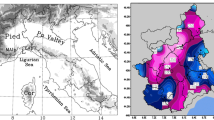Abstract
A five-level primitive equation model in a (x, y, p, t) coordinate system has been developed. A fairly sophisticated scheme of physical processes has been incorporated in the model. The model physics include air-sea interaction, cumulus parametrization, large scale condensation, dry convective adjustment, horizontal and vertical diffusion and simulated radiation. The initial balance between mass and motion fields has been obtained through a dynamic initialization scheme. The model has been integrated upto 48 hr using input data of a case of monsoon depression. The results of initialization and forecast have been presented and discussed. Wind, temperature and vertical velocity fields have been found to retain the observed map features; after the initialization, however, the surface pressure has been considerably modified. The model produced a reasonably good forecast up to 24 hr as far as the flow fields, rainfall region, structure of the depression and the movement of cyclonic circulation were concerned and beyond that damped rapidly. The rainfall rates were underestimated. Some of the shortcomings of the model are also discussed.
Similar content being viewed by others
References
Asselin R 1972Mon. Weather Rev. 100 487
Bedi H S, Datta R K and Krichak R L 1976Meteorol. Gidrol. 5 39 (in Russian)
Das P K and Bedi H S 1978Indian J. Meteor. Hydrol. Geophys. 29 375
Electronic Computation Centrejma 1980 Outline of the operational numerical weather prediction atjma, Tokyo, 21 pp
Kanamitsu M 1975 On numerical prediction over global tropical belt Report 75-1, Department of Meteorology, Florida State University, 97 pp
Kiangi P M R 1977Arch. Meteorol. Geophys. Bioklimatol. A26 349
Krishnamurti T N, Kanamitsu M, Godbole R, Chang C B, Carr F and Chow J H 1976J. Meteorol. Soc. Jpn 54 208
Krishnamurti T N, Molinari J, Pan H L and Wong V 1977Pure. Appl. Geophys. 115 1357
Kuo H L 1965J. Atmos. Sci. 22 40
Kuo H L 1974J. Atmos. Sci. 31 1232
Leith C E 1969Proc. Wmo/iugg symposium on numerical weather prediction, Tokyo 1968 (Tokyo: Japan Meteorological Agency) Vol. 1, p. 41
Manabe S, Smagorinsky J and Strickler R F 1965Mon. Weather Rev. 93 769
Okamura Y 1975J. Meteorol. Soc. Jpn 53 175
Phillips N A 1957J. Meteorol. 14 184
Singh S S 1977Some aspects of prognostic and diagnostic studies of Indian summer monsoon. Ph. D. thesis, Banaras Hindu University, Varai, India, 32–74
Singh S S 1983 A limited area five level primitive equation model, Scientific Report R-038, Indian Institute of Tropical Meteorology, Pune
Singh S S and Saha K R 1976Proc. of IITM Symp. on Tropical Monsoons, Pune, India 1976 p. 43
Singh S S, Kulkarni A A and Sikka D R 1980Mon. Weather Rev. 108 1315
Temperton C 1976Q. J. R. Meteorol. Soc. 102 297
Winninghoff F J 1973Mon. Weather Rev. 101 79
Author information
Authors and Affiliations
Rights and permissions
About this article
Cite this article
Singh, S.S. Short range prediction with a multi-level primitive equation model. Proc. Indian Acad. Sci. (Earth Planet Sci.) 94, 159–184 (1985). https://doi.org/10.1007/BF02871948
Received:
Revised:
Issue Date:
DOI: https://doi.org/10.1007/BF02871948




